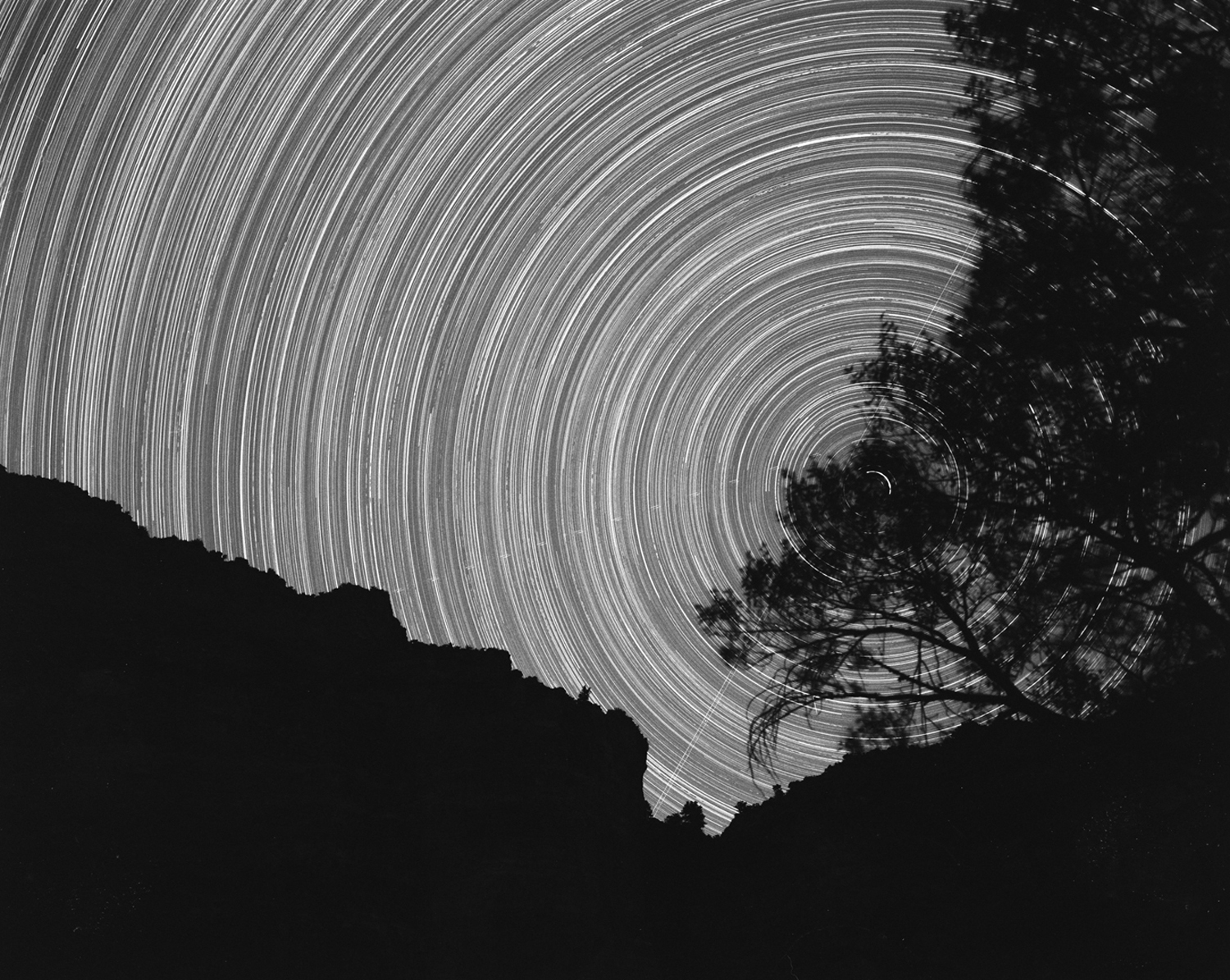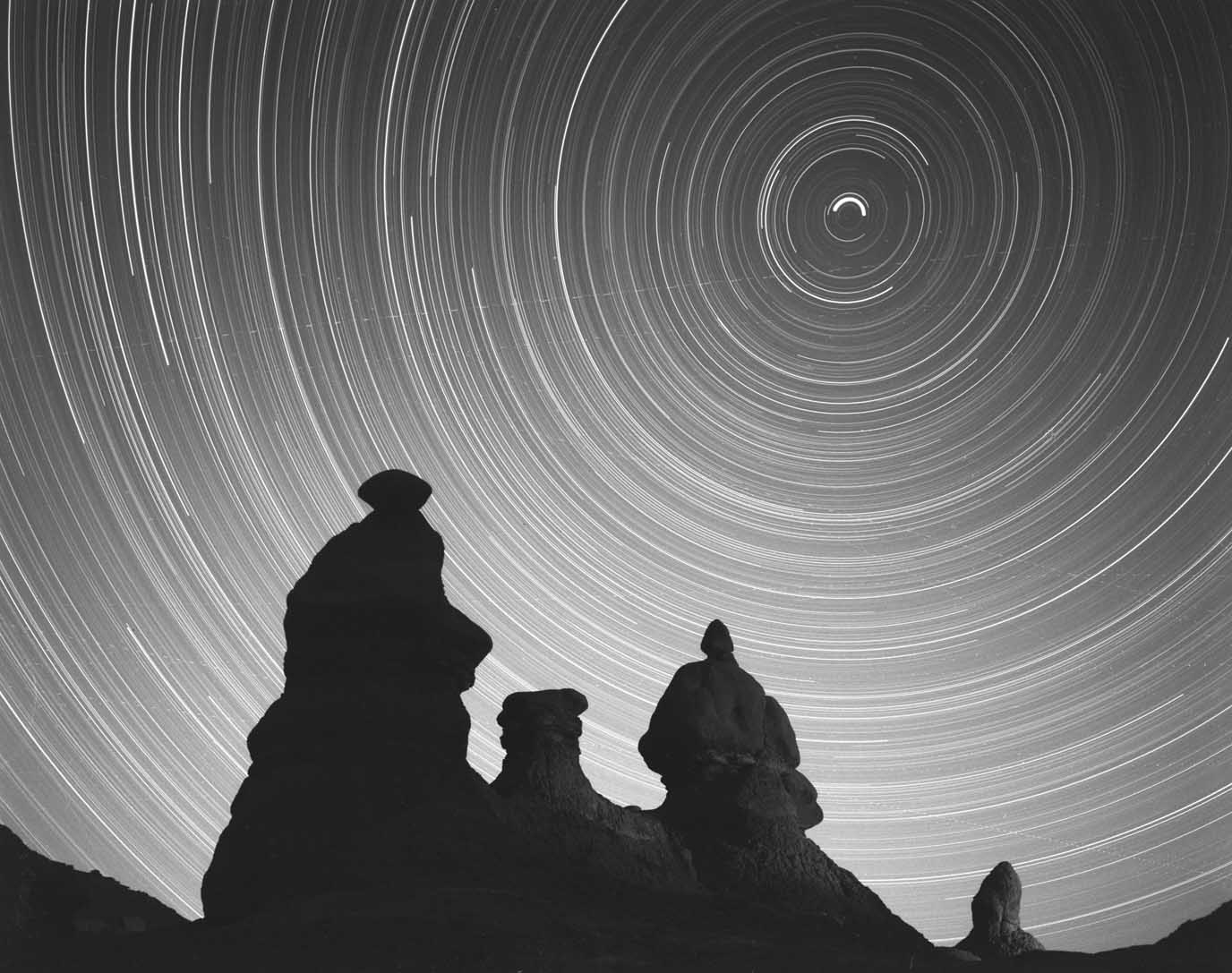

Craig Pindell, Fine Art Photographer
All work copyright Craig Pindell, 2025
Star Trails
The start of the process to learn how to make these star trail photographs was truly an accident that grew into something amazing.
First, a little about the process. These images are very long exposures, between 8 and 10 hours, depending on the sunset and sunrise. The exposure starts about an hour after sunset and ends about an hour before sunrise. I learned this process through several failed efforts. Each time the image didn't work out, I would spend some time sorting out why it didn't work and would make a plan for the next time I had an opportunity to try again.
Opportunities were infrequent, though. The weather had to be clear and calm. There had to be a clear view of the sky, and for me it work's best when Polaris (the North Star) was in the composition. The location had to be secure, isolated and not likely to have interlopers - human or wildlife. When I started these, light pollution was not an issue very often. Now it is really difficult to find a truly dark spot. It helps that there are Dark Sky certified locations, but even at these, an 8 hour exposure will show that the light pollution is still present.

This is the photograph that started me down this long winding path. I made the exposure at a lake near the town where I was living. This was at sunset, and I thought I had color film in my camera. While the camera was still making the photo, I kept metering the scene. The light level was dropping so I kept the shutter open to try save the photo. Eventually it was completely dark, so I gave up, closed the shutter and went home.
The first surprise was when I opened the camera and there was Kodak Panotomic X rather than color film. Pan X was a black and white film that had terrific tones, but was incredibly slow speed. Not at all suited for sunset photos.
I developed the film, but had little hope there would be a useable negative from the sunset. I was surprised to see the image on the film. I was excited to make a print, and as soon as the negative dried, I headed into the darkroom to see what I could create. As soon as the first print image appeared in the developer, i was heartbroken. There was a white line in sky, behind the upper branch of the tree. At first I thought I must have scratched the negative somehow, but noticed the while line didn't go through the branch, so it couldn't have been a scratch. I was stumped, so I took the negative to my favorite camera shop and asked the guru there what it might be. When he told me it was a star trail because of the long exposure, I was dumbfounded. It never occurred to me that the stars would move during a long exposure.
Back then, there was no Google, and trying to find information on star trail photography was difficult, to say the least. After many failed attempts, I began to sort out what would work and what wouldn't. Eventually I put things together in a way that allowed me to have a keeper now and then - an image worth printing, even if only once in a while. That changed when I made this photo deep in a canyon in Utah:

This image was created at the Shaffer Trail Campground near Island in the Sky. It was a moonless night with no clouds. My friend Graig Marrs and I were photographing in the area, and we had this campground to our selves on this night. In a deep canyon like this, the sun sets early, but twilight lasts a long time. I set up the camera and focused on the rock formation. I made my best guess where the North Star (Polaris) would be in the composition. (I guessed it would be on the left side of the center of the image, but I was wrong, as you can tell. It is the star with the smallest diameter circle - on the upper right side of this image.)
Once the camera was set, I waited for total darkness. Light on the horizon detracts from the image, and I knew from previous attempts that I had to be patient and start the exposure later than I had before. Graig and I fixed dinner, then crawled into the tent for the night. I had just gotten warmed up and was setting my alarm to get up well before sunrise when I remembered I forgot to open the shutter on the camera. As a result, this exposure didn't start until after 9PM, and I closed the shutter just after 5:30AM. It was the latest start and the longest exposure I had made up until then.
Once I developed the film, I knew it was one of the best accidents I could have made. The late start allows the stars the stand out in the night sky, and the longer exposure created longer "trails" for each star, enhancing the concentric circle pattern.

This image is from Ten Sleep Canyon, Wyoming. Taken in October when the nights are long, and chilly. The air seems clearer when it is cool, and deep in the canyon there was no wind. I knew it would be unlikely the trees wouldn't move during the 10 hour exposure, but luck was on my side, and this image worked out.

Halloween night. Goblin Valley State Park, Utah. I had always wanted to go to Goblin Valley for Halloween, but it was one of those trips that just never seemed to happen. When it finally came together, I was blessed with dark, cloudless skies and calm winds. Finding this location was not too difficult, but hiking back to camp after opening the shutter was an adventure. The next morning at 6:30 am, hiking from camp to the location was treacherous. everything looks different when lit by a headlamp, and the carefully chosen landmarks seemed to evaporate somehow. I did eventually find the camera and closed the shutter before sunrise. More lessons learned.

My favorite star trail photograph, so far. The Castle, Guernsey State Park, Wyoming. I had wanted to do this photo for many years, and had planned it over and over in my mind. I had tried to do this, and failed several times.
One of the challenges was that camping is not allowed at this location, and while technically I wouldn't be camping, the park security folks had told me that they expect folks to leave the area by 10PM. When I explained what I was doing, one officer was willing to give me a couple of extra hours, but I suspected that wouldn't be enough for the long trail effect I had envisioned. I tried to make the photo two different nights on that visit, and there were clouds and other visitors on both nights. Eventually I decided to return to the park when there would be fewer tourists.
I went back in late October and not only were there fewer tourists, there were fewer security officers as well. I decided to take a chance on staying at the Castle the entire night. When the sky was as dark as it was going to be, I placed a 300 watt photo flood light inside the west room of the Castle and made a 4 second exposure. I ran an electrical extension cord from the inverter in my van into the Castle, because there is no electricity in the structure itself. After the short exposure was complete, I moved the van away from the structure and opened the shutter for the 10 1/2 hour exposure.
I used a small flashlight to paint the west exterior wall of the building with light. Each area received about 20 seconds of light, and I tried to keep it as even as possible and not allow any light to illuminate the pine trees near the structure. I didn't want the building to just be a silhouette with a bright interior, and I guessed at the exposure required to show the texture in the stone wall.
I knew that this was the camera position that worked best to show the west facade of the Castle, but it wasn't optimal for location of the North Star. If I changed camera position to include Polaris, the Castle wouldn't be as interesting, photographically. I decided that lighting the inside of the Castle and the west facade would make the Castle the point of interest, instead of the star trails.
In the end, I think it worked out fine.